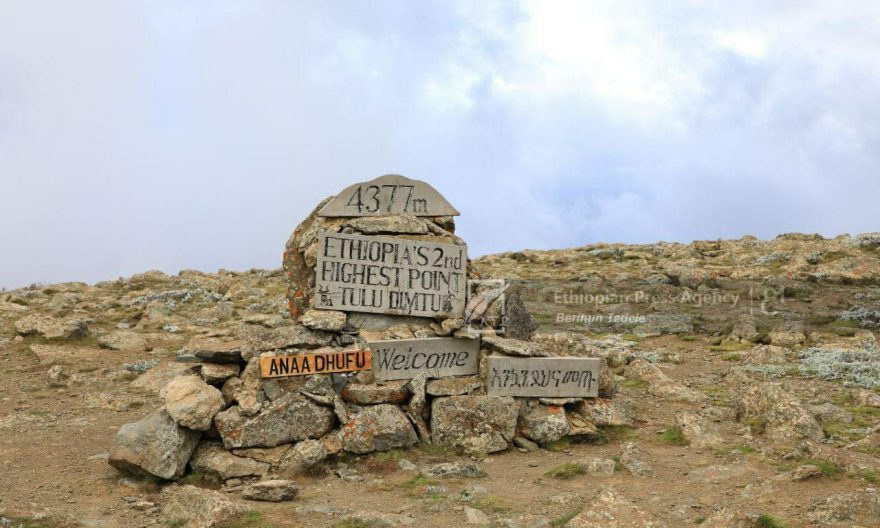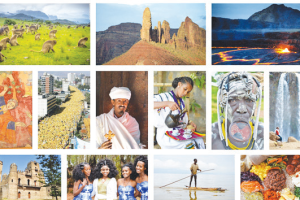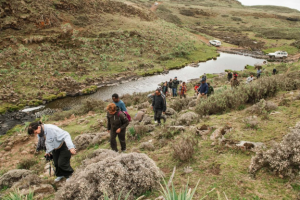
Ethiopia has joined UNESCO since 1955. The nation had registered its first world heritages with the Rock-Hewn Churches of Lalibela as a cultural heritage and Simien National Park as a natural heritage in 1978. After this, the nation had got registered the Gondar Fasil Castle (1979), Axum Obelisk, Tiya, Lower Valley of the Awash and Omo rivers (1980), as well the Harar Jugol, the Fortified Historic Town by 2006, the Konso Cultural Landscape in 2011, among others.
Recently, two more Ethiopian sites were inscribed on UNESCO’s World Heritage list. The United Nations Education, Science and Cultural Organization in its 45th assembly held in Riyadh, Saudi Arabia, inscribed the Ethiopian Bale Mountains National Park (BMNP) and the Gedeo Cultural Landscape.
According to the Ministry of Tourism, following the inscription of Gedeo Cultural Landscapes on the UNESCO World Heritage list, the number of UNESCO-inscribed cultural and natural heritages in Ethiopia has reached 10, the 100th in Africa.
The inscription of the sites brings prestige to raise greater awareness for heritage protection and preservation and immense social and economic return for local people and the country as well as to gain support activities for the preservation of the sites, it was learnt.
In an interview held with The Ethiopian Herald, weeks before the inscription of the two sites in UNESCO’s Heritage list, Cultural Heritage Research Director with the Authority for Research and Conservation of Cultural Heritage Andualem Girmaye had confidently reflected his view regarding the registration of the Ethiopian Bale Mountains National Park (BMNP) and the Gedeo Cultural Landscape on the World Heritage List.
The country has submitted an advanced nomination dossier for the registration of the two heritages thereby anticipating the UNESCO to inscribe them in its world heritage list during the Extended 45th Session of the World Heritage Committee that will be held next month in Saudi Arabia, he had said optimistically while talking the efforts exerted to realize the objective of registering the sites.
In return, Ethiopia was appreciated for advanced dossier on the nomination of the two heritages during the World Heritage Nomination Workshop held in 2020. On the occasion, representatives from Ethiopia introduced the progress of the nomination of the two heritages which are currently inscribed on UNESCO’s list of potential World Heritage sites, it was learnt.
At the workshop, UNESCO had reaffirmed its commitment to provide support to increase East African countries’ representation on the World Heritage List.
According to Andualem, Ethiopia is one amongst the countries that have registered their tangible and intangible heritages in the UNESCO’s world heritage list. So far, UNESCO has recognized a total of 15 – four intangible and 11 tangible Ethiopian heritages and additional heritages are on the way to be inscribed.
The Authority is working on the registration of additional heritages such as ShewalEid, the oral customary laws of Somali Issa community in Ethiopia, Wolaita’s people’s New Year celebration called Gifata, and the prehistory of Melka Kunture and Balchit archeological site in Oromia state, he noted.
It is to be recalled that Ethiopia was elected to the Intergovernmental Committee of Intangible Cultural Heritage during the 9th session of the General Assembly of States Parties to the 2003 UNESCO Convention for the Safeguarding of Intangible Cultural Heritage in 2022.
The selection of Ethiopia as a member is a big achievement to the nation since Ethiopia has registered many tangible and intangible heritages and is working to register more in the UNESCO World Heritage list, Andualem remarked.
As one of the representatives of Africa, Ethiopia will work for a more balanced and truly representative heritage list reflecting the beauty and diversity of the world. It also works for the preservation of intangible cultural heritage that contributes to sustainable development, he added.
He also said that the Gedeo Cultural Landscape and Bale Mountains National Park are home to various fauna and flora and archeological sites.
Meanwhile, the Ethiopian Wildlife Conservation Authority disclosed that it earned over 132 million Birr from those tourists visiting national parks across the country over the last fiscal year.

National Parks Administration Chief Executive Officer Adane Tsegaye (PhD) told the Ethiopian Press Agency (EPA) that it secured the aforesaid amount of revenue over the just ended fiscal year as a total of 141,000 visitors (125,000 domestic and 16,000 foreign ones) visited the National parks.
The visited national parks with high rate of tourist flow are Nechisar National, Mago National, and Bale and Semen mountains national Parks, whereas parks with low visiting rate due to lack of infrastructure and remoteness of their location include Gambela National Park, Altash, and Geral, and Omo National Park, he said.
He said: “Ethiopia has not secured revenue out of its national parks as it deserves, and the system by which visitors are charged a small fee is not encouraging tourism. In addition, illegal hunting and settlement, deforestation in parks do have a direct bearing to the low level of tourists/visitors inflow. Yes, illegal settlement in parks, especially around elephant shelters, is highly damaging the parks.”
Although tourism can earn foreign currency as lucratively as other sectors, it has not so far helped the nation to benefit out of it following various security and development problems, he added.
The Authority has studied ways to make foreign visitors pay fees in USD during their stay in the country, and increase the quality of the parks thereby promoting the tourism potential. Upon approval, the study will help Ethiopia increase income from tourism and earn direct foreign currency, he said.
In sum, developing national parks for tourism destinations requires the commitment and active involvement of the local community, private partners, pertinent stakeholders and the government. Developing national parks as tourist spots would be a preferable approach to save the country’s wildlife heritages and render local communities mutually beneficiaries.
BY TEWODROS KASSA
THE ETHIOPIAN HERALD FRIDAY 22 SEPTEMBER 2023





